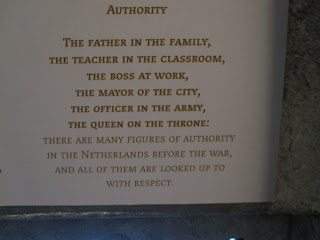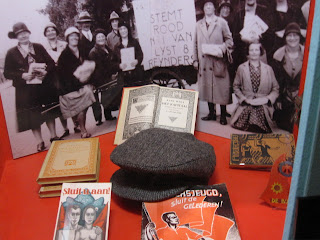we went to the verzets museum, or dutch resistance museum. this has been repeatedly chosen as the best historical museum in the netherlands, and works to demonstrate how the dutch lived before, during, and after the Nazi occupation of the Netherlands. here's the exterior:
first you learn about wally van hall, who is called the banker of the resistance. he, with the approval of the in-exile Dutch government, "robbed" the national dutch bank of more than 50 million guilders, which was used to fund the resistance movement in occupied Holland. read the article linked above.
one resistance (known as the NSF) worker kept notes about who had received money in a copy of mein kampf, knowing the nazis would never look there.
list of fallen NSF workers. wally van hall was executed in 1945, after a betrayal in his group, as retaliation for the death of a high ranking police officer.
scenes of dutch life before the occupation, on the tail end of the great depression. ironically, the netherlands before the german occupation (in my and ryan's opinions) very much mirrors the situation in america now:
i mean, right? if you can't read it, it says:
dutch society... prior to the German invasion:
-in the grips of an economic crisis;
- sees big discrepancies between the poor and the rich;
- is divided into different political and religious pillars, each with it's own political party, newspapers, clubs and even schools; - takes pride in national symbols that transcend politics: the Dutch Royal Airlines, damming and drainage projects, the state orchestra, the dutch football team;
- has faith in the strength of an army that was undergone little modernization since 1900;
- is informed by dozens of newspapers about the growing threat of war;
- trusts that things will sort themselves out.
the dutch have a high regard for authority, and succinctly explained above.
these things were left at the monument of queen emma, on prince bernard's brithday 1940, after the queen and government had left for self-imposed exile in london right ahead of the invading forces. the dutch loved their royal family, especially queen wilhelmina, whose face is on mints. she was beloved for her frequent broadcasts to the dutch resistance via the BBC.
close-up of the flowers left at the monument. this is just for the prince's birthday. imagine what it looked like on queen's day!
this is a picture of a dutch family in amsterdam. all but 2 members died before or during the war.
a baby shoe that was left at the hollandsche schouwburg, the theatre that was used as a primary gathering point for deported dutch jews.
this is a bad shot, but a girl who lived behind this theatre took a picture of her friend greetje, who was interned here before being deported to westerbork, and later auschwitz where she died.
this little boy was orphaned, and was raised in the orphange/ child-care center across the street from the theatre. some resistance members were able to smuggle out small children in hand baggage, and in fact many children were saved this way. but this little boy caught the eye of a german guard, who made a pet of him, and gave him a teddy bear and chocolate. this lack of anonymity is what doomed him, as the resistance could not risk the questions his absence would have caused.
this photos are jewish children who successfully hid in the country after the bombing of rotterdam by claiming to be refugees. in fact, they were from all over holland.
inmate drawings of westerbork concentration camp.
letter from a deported dutch jew from westerbork.
The Dutch held several strikes to protest the Nazi invasion, in fact no other country in occupied europe showed such strong refusal to cooperate with the invading forces. this man was arrested after the april-may strike (the milk strike, because it began with dairy workers). on the 2nd day of the strike, the germans held a roll call on the grounds of the stork machine factory. when he is discovered missing, he is summarily arrested. though he truthfully responds that he had BEEN GIVEN THE DAY OFF, death sentences need to be carried out. the man does not distance himself from the strike. his family is given only the contents of his pockets.
ration cards.
micro film hidden inside a razor handle.
a watch with secret scrolls for carrying information.
this is a picture of 2 women; the one in front is disguised as a man. this is Hannie Schaft and her partner. they worked to liquidate traitors. as she explains, "we had no prisons." she says she and her partner would pretend to be "necking" and she would aim the pistol and shoot. she has bright red hair, so when the germans catch wind of a red head, she dyes her hair jet black and adopts glasses. it does no good; she is caught and executed.
forging identity cards.
items made in concentration camps.
resistance workers would often hide the most dangerous items (weapons, ammunition, papers) would be carried in baby carriages. the germans did not suspect or search these as thoroughly as other items.
a christmas tree made in a concentration camp.
this letter was written in blood.
a game of chess that was passed between 2 inmates at a concentration camp. each player got one move per day, as it the board made 2-3 transfers to get back and forth between them.
a dutch kitchen during the hunger winter.
a flask for carrying milk during the famine. this was designed to be hidden under one's coat.
liberation.
food drops by the allies.
scenes from liberation.
the american soldiers were very popular with the dutch girls. it took a long time for soldiers to return, and american soldiers began spending their furloughs in amsterdam, known as the "love center" (still is). the government put out all kinds of warnings, but nonetheless, more than 4000 babies were born to the american soldiers.
a woman who had a relationship with a german soldier is having her head shaved by dutch people.
there was a temporary exhibit: love in wartime, which was very interesting and examined the different places and kinds of love that flourished during the war. but most of the exhibit was in dutch, which i still don't speak.
war time wedding dress.
haha. american and british soldier rivalry.
after the museum, we walked by the auschwitz memorial, created by jan wolkers. it's made of broken mirrors, which constantly reflect the sky.


















































No comments:
Post a Comment